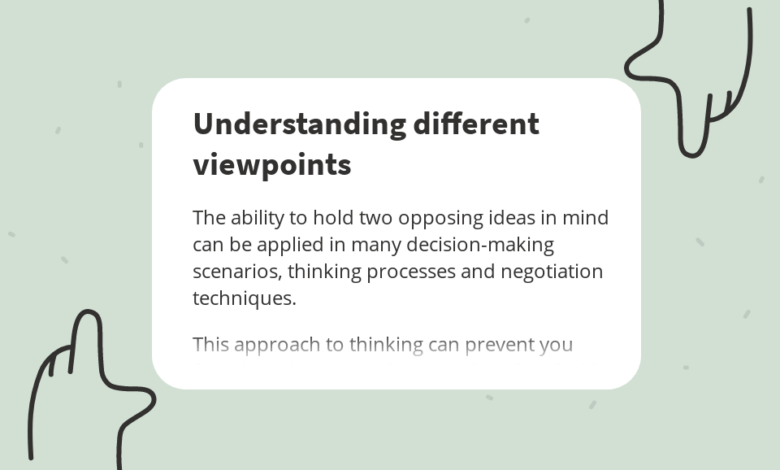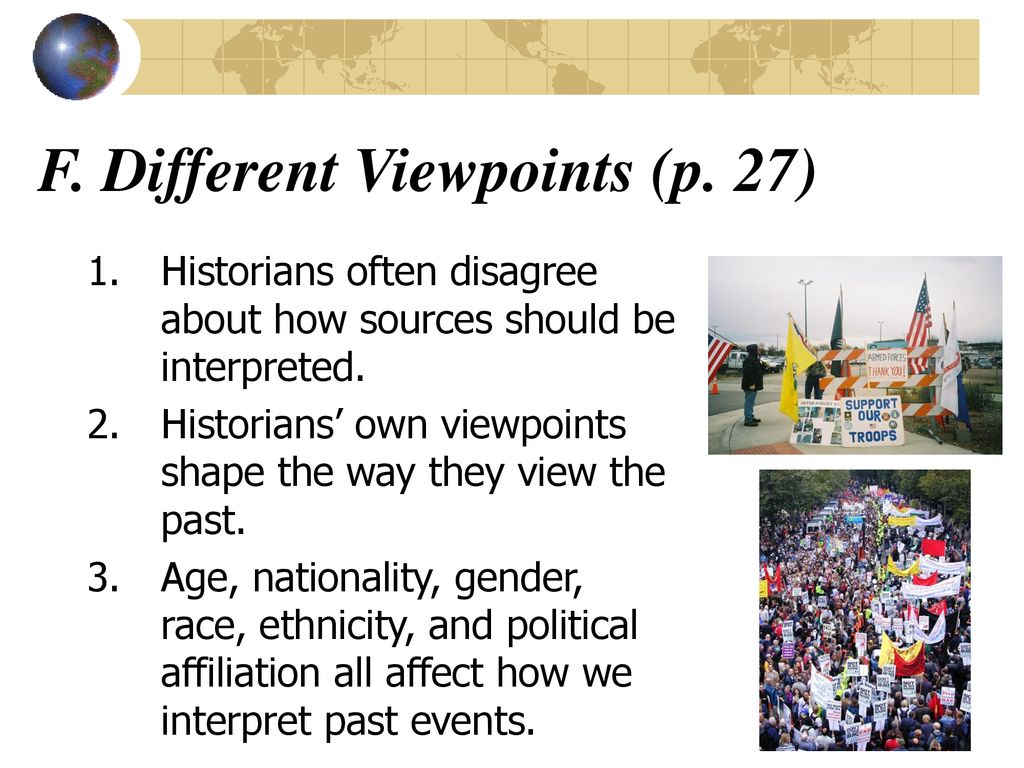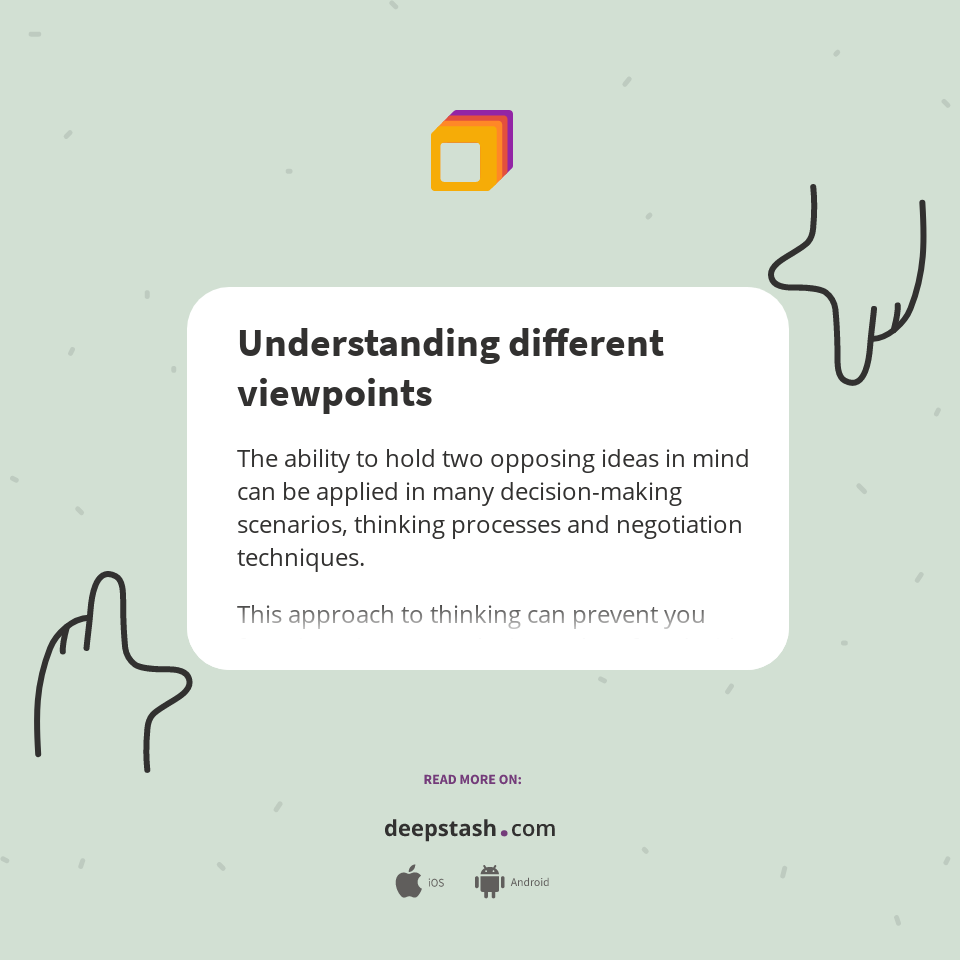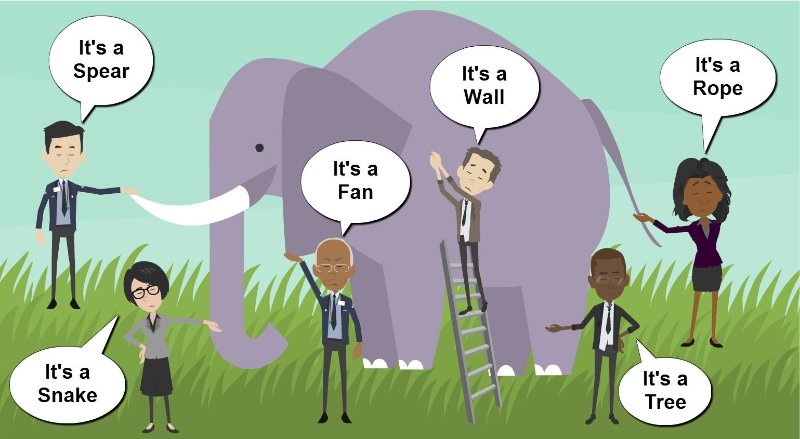
New Perspectives The Other Side
New perspectives the other side: This journey explores the power of stepping outside our own limited viewpoints to understand opposing beliefs and experiences. It’s about challenging ingrained biases and embracing empathy to foster connection, solve conflicts, and unlock unexpected opportunities for personal growth and societal progress. We’ll dive into real-world examples, fictional scenarios, and practical strategies to help you navigate the complexities of differing perspectives and build bridges of understanding.
From everyday disagreements to global conflicts, the ability to see things from another’s point of view is paramount. This exploration isn’t just about tolerance; it’s about actively seeking out diverse viewpoints to enrich our own lives and create a more collaborative and innovative world. We’ll examine how active listening, effective communication, and a willingness to challenge our own beliefs can lead to profound personal transformation and significant positive change.
Exploring Different Viewpoints
Understanding the perspectives of others is paramount to navigating the complexities of human interaction. It’s a skill that fosters empathy, promotes collaboration, and ultimately leads to more effective solutions in various aspects of life, from personal relationships to international diplomacy. Without actively seeking out and considering alternative viewpoints, we risk misunderstandings, conflict, and missed opportunities for growth and progress.Understanding “the other side” is crucial in conflict resolution because it allows for a more nuanced and comprehensive understanding of the situation.
Ignoring opposing perspectives often leads to entrenched positions and unproductive arguments.
Conflict Resolution Examples
Consider a workplace disagreement between a manager and an employee regarding a project deadline. The manager, focused on meeting client expectations, might view the employee’s request for an extension as a lack of commitment. However, understanding the employee’s perspective—perhaps they’re facing unforeseen personal challenges or are overwhelmed by other responsibilities—can lead to a compromise that benefits both parties. Similarly, international conflicts often stem from a lack of understanding of different cultural norms and historical contexts.
Negotiations that prioritize understanding each other’s motivations and concerns are significantly more likely to achieve peaceful resolutions.
Fictional Scenario Illustrating the Benefits of Seeking New Perspectives
Imagine Sarah, a passionate environmental activist, vehemently opposes a new highway project planned for her community. She believes it will destroy a vital ecosystem. However, she initially dismisses the arguments of the project’s supporters—primarily local business owners who believe it will boost the economy. By actively listening to their concerns, Sarah discovers that the business owners are struggling, and the highway is seen as their only hope for economic revival.
This newfound understanding allows Sarah to propose alternative solutions—perhaps a redesigned highway that minimizes environmental impact while still providing economic benefits. This collaborative approach, born from seeking new perspectives, leads to a more sustainable and equitable outcome for everyone involved.
Personal Biases Hindering Understanding
Personal biases, often unconscious, significantly hinder our ability to see “the other side.” These biases, shaped by our upbringing, experiences, and cultural background, act as filters, distorting our perception of information and making it difficult to objectively evaluate opposing viewpoints. For example, confirmation bias leads us to seek out and favor information that confirms our existing beliefs, while ignoring contradictory evidence.
Similarly, in-group bias causes us to favor individuals within our own social group, often leading to prejudice and discrimination against those outside it. Overcoming these biases requires conscious effort, self-reflection, and a willingness to challenge our own assumptions.
Comparing Approaches to Understanding Opposing Viewpoints
Two distinct approaches exist for understanding opposing viewpoints: empathetic listening and critical analysis. Empathetic listening focuses on understanding the emotional and experiential context behind another person’s perspective. It involves actively listening, seeking clarification, and showing genuine interest in the other person’s feelings and experiences. Critical analysis, on the other hand, involves systematically evaluating the logic, evidence, and assumptions underlying an opposing viewpoint.
Sometimes, seeing things from “the other side” requires a complete shift in thinking. For me, that shift involved understanding the YouTube algorithm – a whole new world! Learning the ins and outs, like explained in this awesome guide, getting it on with YouTube , completely changed how I approach content creation. Now, I can better anticipate audience needs and craft videos that truly resonate, offering a new perspective on my own work.
This approach requires a more detached and objective perspective, focusing on identifying strengths and weaknesses in the argument. While both approaches are valuable, a combination of empathetic listening and critical analysis often provides the most comprehensive understanding. Empathy helps to establish rapport and trust, while critical analysis ensures that the evaluation remains objective and thorough.
Communication and Empathy

Source: slideplayer.com
Understanding and bridging divides requires more than just acknowledging different perspectives; it necessitates effective communication and genuine empathy. Successfully navigating conversations with those holding opposing viewpoints hinges on our ability to connect on a human level, fostering mutual respect and understanding. This involves actively listening, skillfully expressing our own views, and recognizing the validity of others’ experiences, even if we disagree with their conclusions.Effective communication across differing perspectives involves a multi-faceted approach.
It’s not simply about stating our own opinions, but about creating a space where all voices can be heard and considered. This requires a conscious effort to understand the other person’s background, beliefs, and values, even if they differ significantly from our own.
Strategies for Effective Communication
Several strategies contribute to more effective communication across diverse viewpoints. These include clear and concise language, avoiding jargon or overly technical terms; actively seeking clarification when something is unclear; focusing on shared goals or common ground whenever possible; and being mindful of our tone and body language, ensuring it conveys respect and openness. For example, instead of launching into a heated argument, starting with a statement like, “I understand you feel strongly about this, and I want to understand your perspective better,” can significantly de-escalate tension and open the door for productive dialogue.
Similarly, refraining from interrupting and allowing the other person to fully express their thoughts is crucial.
The Role of Empathy in Bridging Divides
Empathy, the ability to understand and share the feelings of another, plays a crucial role in bridging divides and fostering understanding. It’s about stepping into someone else’s shoes, trying to see the world from their point of view, and acknowledging the validity of their emotions, even if we don’t agree with their reasoning. By practicing empathy, we can move beyond simply hearing words to truly understanding the underlying emotions and motivations driving a person’s beliefs.
This doesn’t mean we have to agree with their viewpoint, but it does mean we can approach the conversation with greater respect and understanding. For instance, understanding that someone’s opposition to a policy might stem from a fear of economic insecurity, rather than simple stubbornness, can significantly alter our approach to the conversation.
Active Listening and Gaining New Perspectives
Active listening is more than just hearing words; it’s about fully engaging with what the other person is saying, both verbally and nonverbally. This involves paying close attention to their tone of voice, body language, and the emotions they’re expressing. It also means asking clarifying questions to ensure we understand their perspective fully, and summarizing their points to confirm our understanding.
For example, instead of formulating our response while the other person is speaking, we should focus on truly listening and understanding their message before formulating our own response. This process of attentive listening opens pathways to understanding perspectives that may initially seem contradictory or even hostile.
A Dialogue Demonstrating Effective Communication
Imagine a conversation between Anya, who supports stricter environmental regulations, and Ben, who believes such regulations hinder economic growth.Anya: “Ben, I understand your concerns about economic growth, but I feel strongly about the need for stricter environmental regulations. The current rate of pollution is unsustainable.”Ben: “Anya, I appreciate your passion for the environment, but I worry that these regulations will stifle innovation and job creation in our region.”Anya: “I understand your worry about job losses.
Could you tell me more about the specific industries you’re concerned about?”Ben: “Primarily, the manufacturing sector. Increased regulations would make it harder for them to compete.”Anya: “I see. Perhaps we could explore ways to support these industries while still reducing pollution. Maybe incentives for green technologies could help them adapt.”Ben: “That’s an interesting idea. It might be a way to balance environmental concerns with economic realities.”
The Impact of Perspective Shifts

Source: deepstash.com
Embracing diverse viewpoints isn’t just a feel-good notion; it’s a powerful catalyst for progress and personal growth. Shifting our perspectives, challenging our ingrained beliefs, and actively seeking out different interpretations of the world around us has profound implications for both individuals and society as a whole. This exploration will delve into the societal benefits of embracing diverse perspectives, the personal growth fostered by challenging our worldviews, the obstacles encountered in adopting new perspectives, and finally, how understanding “the other side” fuels innovation and creativity.
Societal Benefits of Diverse Perspectives
The incorporation of diverse perspectives into societal structures leads to more equitable, just, and effective systems. When a multitude of voices are heard and considered, solutions to complex problems become more nuanced and comprehensive. For instance, policies developed with input from individuals from various socioeconomic backgrounds are more likely to address the needs of the entire population, rather than catering solely to the dominant group.
This inclusive approach also fosters stronger communities by promoting understanding and reducing conflict arising from misunderstandings and biases. Consider the example of urban planning: incorporating the perspectives of residents, business owners, and environmentalists results in more sustainable and livable cities.
Personal Growth Through Challenging One’s Worldview
Stepping outside of one’s comfort zone and actively challenging pre-conceived notions is crucial for personal growth. This process often involves confronting deeply held beliefs and biases, leading to a more nuanced and self-aware understanding of oneself and the world. For example, someone raised in a highly homogenous environment might discover a new appreciation for cultural diversity by traveling or engaging with individuals from different backgrounds.
This process of self-reflection and expansion of understanding can lead to increased empathy, reduced prejudice, and a greater capacity for critical thinking. The discomfort of confronting one’s own biases is often a necessary step toward becoming a more well-rounded and open-minded individual.
Obstacles to Adopting New Perspectives
Several obstacles hinder the adoption of new perspectives. Cognitive biases, such as confirmation bias (the tendency to seek out information confirming pre-existing beliefs) and in-group bias (favoring one’s own group), can significantly impede the ability to objectively evaluate different viewpoints. Furthermore, fear of the unknown, ingrained prejudices, and a lack of exposure to diverse perspectives can all create barriers.
Social and cultural norms can also reinforce existing biases, making it difficult for individuals to question or challenge them. Overcoming these obstacles requires conscious effort, self-reflection, and a willingness to engage with information that challenges our existing beliefs.
Innovation and Creativity Through Understanding Diverse Viewpoints
The ability to understand and integrate diverse perspectives is a crucial driver of innovation and creativity. When individuals from different backgrounds and with varying expertise collaborate, they bring unique skills, knowledge, and perspectives to the table. This fusion of ideas can lead to the development of novel solutions and approaches that would not have been possible within a homogenous group.
Consider the development of technological products: a team composed of engineers, designers, and marketers, each with their unique perspective, is far more likely to create a successful product than a team composed solely of engineers. The ability to see a problem from multiple angles unlocks creative potential and leads to more robust and effective solutions.
Case Studies: New Perspectives The Other Side

Source: priyankadutta.com
Understanding different perspectives isn’t just a philosophical exercise; it’s a practical skill with tangible consequences. The following case studies illustrate how shifts in perspective, both large and small, can dramatically alter outcomes, from resolving conflicts to fostering innovation. We’ll explore real-world examples and hypothetical scenarios to highlight the power of embracing diverse viewpoints.
A Shift in Perspective Leading to Positive Outcomes
The following table details a case study where a change in perspective resulted in a positive outcome. This illustrates how understanding another’s point of view can lead to successful problem-solving.
| Situation | Initial Perspective | Shifted Perspective | Outcome |
|---|---|---|---|
| A software development team facing project delays. | The team blamed the delays on insufficient resources and a complex project scope. | The team considered the perspectives of the clients, who felt unheard and lacked transparency into the development process. They realized their focus on technical challenges overshadowed the clients’ needs and concerns. | By implementing improved communication and incorporating client feedback, the team addressed the root cause of the delays and delivered a successful product, improving client satisfaction and strengthening the working relationship. |
Historical Example: Preventing Conflict Through Understanding, New perspectives the other side
The Helsinki Accords of 1975, signed by 35 countries including the United States and the Soviet Union, provide a powerful example of how understanding “the other side” prevented conflict. During the Cold War, these nations held deeply contrasting ideologies. However, by engaging in dialogue and acknowledging each other’s security concerns, the accords established a framework for cooperation in areas like trade, human rights, and environmental protection.
While not eliminating Cold War tensions entirely, the Helsinki Accords represented a significant step toward de-escalation and peaceful coexistence, demonstrating the power of acknowledging and addressing differing perspectives.
Fictional Example: Ignoring Diverse Viewpoints
Imagine a fictional town where the local council plans to build a new highway, prioritizing economic growth. The council focuses solely on the projected economic benefits, ignoring the concerns of residents who live near the planned route. These residents worry about noise pollution, air quality, and the potential devaluation of their properties. The council’s failure to understand and address these concerns leads to significant public backlash, protests, legal challenges, and ultimately, delays and increased costs for the highway project.
This highlights how neglecting diverse perspectives can result in unforeseen negative consequences, impacting not only the affected community but also the project’s overall success.
Hypothetical Example: Embracing Diverse Perspectives for Success
A university is developing a new curriculum focused on sustainability. By actively incorporating the perspectives of students, faculty, local businesses, and environmental organizations, the university crafts a comprehensive program that addresses various needs and viewpoints. Students contribute ideas for relevant coursework, faculty provide academic expertise, businesses offer internship opportunities, and environmental groups ensure the curriculum reflects current environmental challenges and best practices.
The resulting curriculum is well-rounded, engaging, and relevant, leading to high student enrollment, successful graduates, and positive community impact. This demonstrates how embracing diverse perspectives can lead to a more comprehensive and effective solution.
Visual Representation of Perspectives
Visualizing the concept of perspective-taking can be a powerful tool for understanding and promoting empathy. By creating mental images, we can more effectively grasp the complexities of seeing the world from another’s point of view. This exploration delves into the visual metaphors that can illuminate this crucial aspect of human interaction.Imagine a single, perfectly round orb, representing a situation or problem.
From one side, vibrant, sunny colors dominate, suggesting optimism and a sense of easy solutions. On the opposite side, the orb is shrouded in dark, muted tones, depicting hardship, challenges, and a sense of overwhelming difficulty. This simple image demonstrates how drastically different the same situation can appear depending on the observer’s position and perspective. The contrasting colors serve as a potent visual metaphor for the wide spectrum of interpretations a single event can evoke.
Overlapping Perspectives
A visual representation of intersecting perspectives could be depicted as a series of overlapping translucent circles, each a different color and representing a distinct viewpoint. Where the circles overlap, new colors are created, representing the synthesis of ideas and the emergence of shared understanding. The areas where circles do not overlap highlight the unique aspects of each individual perspective.
The varying degrees of transparency symbolize the varying levels of influence each perspective has on the overall understanding. The more opaque a circle, the more dominant that particular viewpoint is in the final synthesis. The image would visually represent the complexity of multiple perspectives interacting, some harmonizing, others remaining distinct.
Symbolic Image of Perspective Shifts
A symbolic image representing the challenges and rewards of adopting new perspectives could depict a climber ascending a steep, rocky mountain. The path is initially narrow and treacherous, representing the initial difficulty and discomfort of challenging pre-existing beliefs and biases. However, as the climber ascends, the view expands, revealing breathtaking vistas and a wider understanding of the landscape.
The mountain itself represents the journey of perspective-taking, the rocks symbolize the obstacles encountered along the way, and the panoramic view from the summit embodies the expanded awareness and enhanced understanding gained through the process. The climber’s struggle illustrates the effort required, while the summit view represents the rewards – a broadened understanding and a sense of accomplishment.
Final Summary
Ultimately, embracing “the other side” isn’t about abandoning our own convictions; it’s about expanding our understanding and recognizing the validity of different perspectives. By cultivating empathy, practicing active listening, and challenging our own biases, we can unlock new levels of creativity, collaboration, and personal growth. The journey to understanding the other side is a continuous process, but the rewards – both personal and societal – are immeasurable.
Let’s continue to learn, grow, and build bridges together.
FAQs
What if I disagree fundamentally with someone’s perspective?
Even with fundamental disagreements, respectful dialogue and active listening can foster understanding. Focus on finding common ground and exploring shared values, even if ultimate agreement isn’t possible.
How can I overcome my own biases when considering other perspectives?
Self-reflection is key. Identify your own biases and prejudices honestly. Seek out diverse viewpoints and actively challenge your assumptions. Consider seeking feedback from trusted sources to gain external perspectives on your biases.
Is it always necessary to compromise to understand the other side?
Compromise isn’t always necessary or even desirable. Understanding the other side involves acknowledging and respecting different perspectives, even if you maintain your own stance. The goal is mutual understanding, not necessarily agreement.
